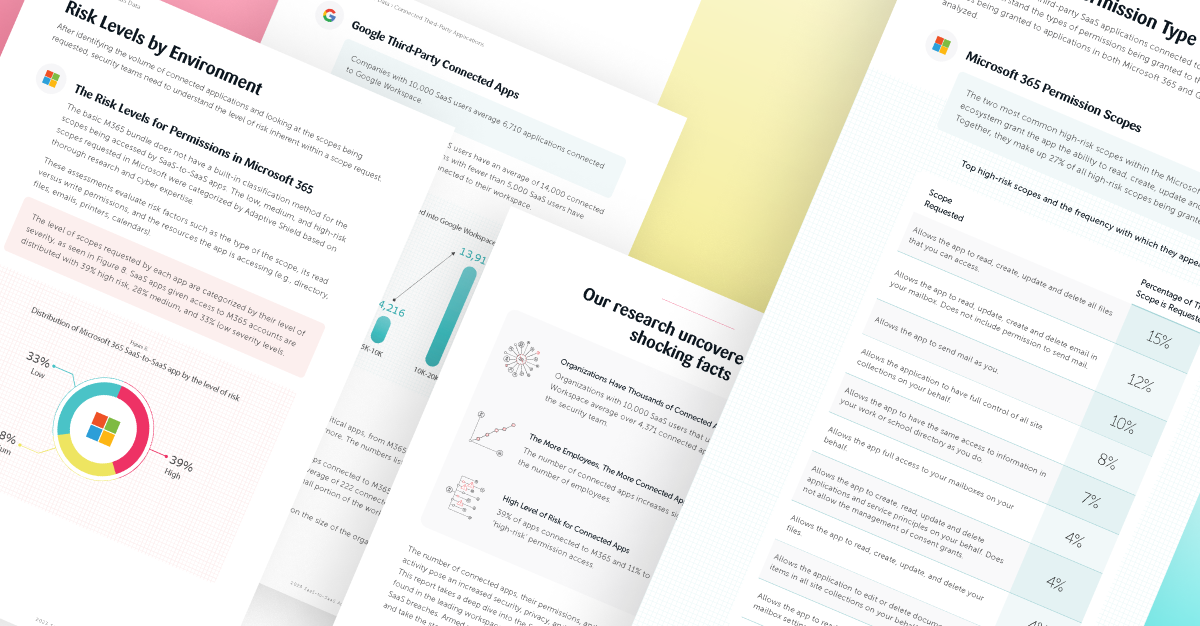Spoiler Alert: Organizations with 10,000 SaaS users that use M365 and Google Workspace average over 4,371 additional connected apps.
SaaS-to-SaaS (third-party) app installations are growing nonstop at organizations around the world. When an employee needs an additional app to increase their efficiency or productivity, they rarely think twice before installing. Most employees don’t even realize that this SaaS-to-SaaS connectivity, which requires scopes like the ability to read, update, create, and delete content, increases their organization’s attack surface in a significant way.
Third-party app connections typically take place outside the view of the security team, are not vetted to understand the level of risk they pose.
Adaptive Shield’s latest report, Uncovering the Risks & Realities of Third-Party Connected Apps, dives into the data on this topic. It reviews the average number of SaaS-to-SaaS apps organizations have, and the level of risk they present. Here are the top 5 findings.
Finding #1: Connected Apps Run Deep
The report focuses on Google Workspace and Microsoft 365 (M365), as it paints a clear picture of the scope of applications that are integrating with the two applications.
On average, a company with 10,000 SaaS users using M365 has 2,033 apps connected to its suite of applications. Companies of that size using Google Workspace have more than three-times the amount, averaging 6,710 connected applications.
Even smaller companies aren’t immune. The report found that companies using M365 average 0.2 applications per user, while those using Google Workspace average 0.6 applications per user.
Finding #2: The More Employees, the More Apps
In contrast to most growth curves, the research shows that the number of apps per user doesn’t level off or plateau once reaching a critical mass of users. Rather, the number of applications continues to grow with the number of users.
As seen in figure 1, companies using Google Workspace with 10,000-20,000 employees average nearly 14,000 unique connected applications. This continued growth is shocking to security teams, and makes it nearly impossible for them to manually discover and manage the high volume of applications.

Finding #3: SaaS-to-SaaS App Risk is High
When third-party apps integrate with core SaaS apps, they gain access using an OAuth process. As part of this process, applications request specific scopes. These scopes hand over a lot of power to the apps.

Among high-risk scopes, 15% of M365 applications request the authority to delete all files that the user can access. It gets even scarier in Google Workspace applications, where 40% of high-risk scopes receive the ability to delete all Google Drive files.
As shown in this permission tab, the application explicitly requests permission to see, edit, create, and delete all Google Docs documents, Google Drive files, Google Slides presentations, and Google Sheets spreadsheets.
For security teams accustomed to controlling the data, permission sets like these are unsettling. Considering that many applications are created by individual developers who may not have prioritized security in their software development, these permissions provide threat actors with everything they need to access and steal or encrypt company data. Even without a threat actor, a bug in the software can have disastrous consequences for a company’s data.
Finding #4: Connected Apps Also Have Tremendous Breadth
While the report deep dives into the big two SaaS apps, it does also release research into Salesforce (and Slack). Salesforce averages 41 integrated apps per instance. The implication of this is noteworthy.
Salesforce is primarily used by a small subset of the company. In that regard, it’s similar to Workday, Github, and ServiceNow, which are used by HR, developers, and finance teams. A typical company with 10,000 employees has over 350 SaaS applications in its stack, many of which are used by smaller departments like the apps discussed here.
Assuming Salesforce is typical of similar applications, those 350 apps integrating with 40 apps each adds an additional 14,000 third-party applications into the equation.
Finding #5: M365 and Google Workspace Have Similar Number of High-Risk Apps
One of the more interesting takeaways was the high volume of high-risk apps connecting to Microsoft compared to Google Workspace. Apps request high-risk permissions from M365 39% of the time; Google Workspace apps only request high-risk permissions 11% of the time. In terms of real numbers, an average installation in a company with 10,000 SaaS users using M365 will have 813 high-risk apps, while Google Workspace will have 738 apps that are considered high-risk.
In all likelihood, this disparity is caused due to the app creation process. Google requires apps requesting high-risk (it calls them Restrictive) permissions to be reviewed. The review process is far easier for those requesting medium, or sensitive, permissions. Microsoft doesn’t label requested scopes with severity levels. This lack of oversight makes it much easier for apps that connect with M365 to request high-risk scopes.
SaaS Security is Far More Complex than Most Recognize
The overall takeaway from reading the report is the immense challenge of securing SaaS software. It’s clear that security teams need visibility into the thousands of apps being connected to the SaaS stack, and make a cost-benefit analysis for each high-risk connected app.
SaaS security solutions, like Adaptive Shield, provide security teams with the visibility needed to see connected applications and their scopes, among other important SaaS security capabilities. Armed with this information, security teams will be in a far better position to harden their applications’ security posture and prevent data from falling into the wrong hands.


















